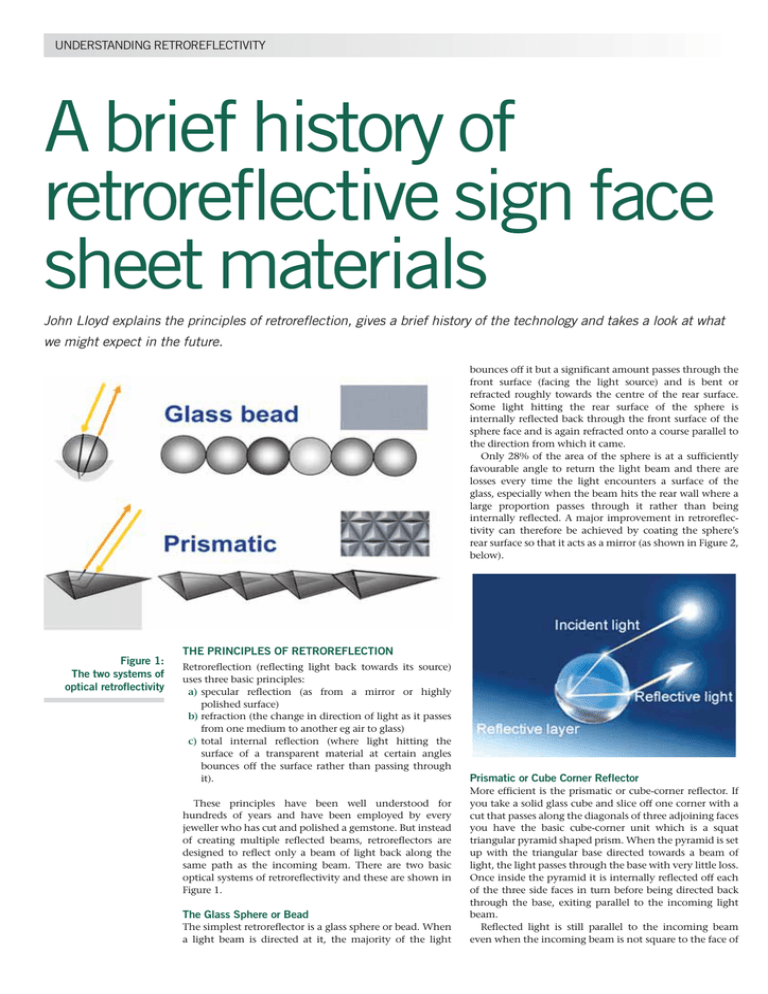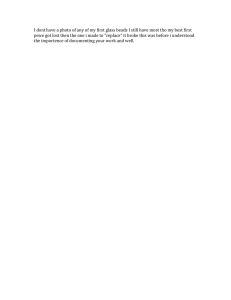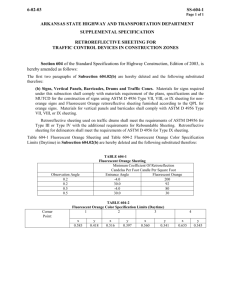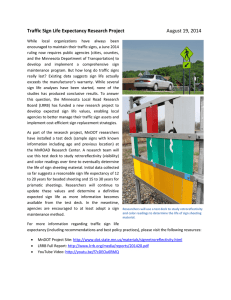A brief history of retroreflective sign face sheet materials
advertisement

UNDERSTANDING RETROREFLECTIVITY A brief history of retroreflective sign face sheet materials John Lloyd explains the principles of retroreflection, gives a brief history of the technology and takes a look at what we might expect in the future. bounces off it but a significant amount passes through the front surface (facing the light source) and is bent or refracted roughly towards the centre of the rear surface. Some light hitting the rear surface of the sphere is internally reflected back through the front surface of the sphere face and is again refracted onto a course parallel to the direction from which it came. Only 28% of the area of the sphere is at a sufficiently favourable angle to return the light beam and there are losses every time the light encounters a surface of the glass, especially when the beam hits the rear wall where a large proportion passes through it rather than being internally reflected. A major improvement in retroreflectivity can therefore be achieved by coating the sphere’s rear surface so that it acts as a mirror (as shown in Figure 2, below). Figure 1: The two systems of optical retroflectivity THE PRINCIPLES OF RETROREFLECTION Retroreflection (reflecting light back towards its source) uses three basic principles: a) specular reflection (as from a mirror or highly polished surface) b) refraction (the change in direction of light as it passes from one medium to another eg air to glass) c) total internal reflection (where light hitting the surface of a transparent material at certain angles bounces off the surface rather than passing through it). These principles have been well understood for hundreds of years and have been employed by every jeweller who has cut and polished a gemstone. But instead of creating multiple reflected beams, retroreflectors are designed to reflect only a beam of light back along the same path as the incoming beam. There are two basic optical systems of retroreflectivity and these are shown in Figure 1. The Glass Sphere or Bead The simplest retroreflector is a glass sphere or bead. When a light beam is directed at it, the majority of the light 2 DESIGNING SAFER ROADSIDES Prismatic or Cube Corner Reflector More efficient is the prismatic or cube-corner reflector. If you take a solid glass cube and slice off one corner with a cut that passes along the diagonals of three adjoining faces you have the basic cube-corner unit which is a squat triangular pyramid shaped prism. When the pyramid is set up with the triangular base directed towards a beam of light, the light passes through the base with very little loss. Once inside the pyramid it is internally reflected off each of the three side faces in turn before being directed back through the base, exiting parallel to the incoming light beam. Reflected light is still parallel to the incoming beam even when the incoming beam is not square to the face of UNDERSTANDING RETROREFLECTIVITY the pyramid, as the light is equally refracted when entering and leaving the prism. The cube-corner pyramid prism is a fairly efficient retroreflector but has two limitations: a) Light entering close to the corners of the triangular base is only internally reflected off the two nearest sides and misses the third side, which is too far away. About 35% of the incoming light is lost in this way. b) As the angle at which the light approaches the entry face becomes shallower, so an increasing proportion of the light will bounce off the surface instead of entering the pyramidal prism. These losses are relatively small where the light hits it within 10º to 15º of square but rapidly increase at more acute angles. If the ‘reflective’ faces of the prism are polished, accurate and perfectly clean, then total internal reflection is achieved when the incoming light hits them but dirty surfaces result in much increased light ‘leakage’. Vacuum metallization of these rear surfaces resolves the cleanliness issue but, surprisingly, a plain pristine surface is slightly more efficient than a mirrored surface in reflecting light. Characteristically, spherical retroreflectors have lower performance but maintain it over a wide range of lighting incidence angles whereas prismatic retroreflectors are much brighter when lit close to head on but perform worse than the spherical reflectors at wider angles of incidence (a sphere presents the same geometry irrespective of the direction of the beam). However, triangular pyramid bases can fit snugly together to form a continuous surface, gathering and returning the incoming light, whereas there are inevitably gaps between glass spheres (comprising about 25% of the total area). Even so, mass producing glass spheres is very much easier than making pyramids with accurate, highly polished facets! The Addition of Retroreflectivity to Traffic Signs Retroreflective sign faces typically employ one or the other of these two simple systems. However, creating large retroreflective sign faces that are both highly and evenly reflective, durable and commercially viable, has been far from simple and improvements are still ongoing after 80 years of development. In the 1920s relatively large glass spheres (10mm to 20mm in diameter) were attached to signs to outline the principal symbols. In parallel cube-corner elements were produced as glass mouldings for similar purposes but again the individual cube–corner pyramids were quite large (in the order of 6mm across). Modern sign faces, however, have their roots in the miniaturisation of these two retroreflective elements. THE DEVELOPMENT OF RETROREFLECTIVE SHEETING USING GLASS BEADS In the1930’s the American company, Potters, made tiny accurate glass spheres or ‘beads’ only a fraction of a millimetre in diameter which were first used on the cinema’s ‘silver screens’ giving a much brighter image. Experiments were made to reflectorize road markings and traffic signs by sprinkling these beads onto a layer of wet paint or adhesive. In 1937 3M developed a retroreflective tape with a surface layer of glass beads for bonding to the road surface but after durability problems, this development effort was switched to vertical road signs. Early trials of sign faces with a layer of beads applied to their surfaces produced retroreflective results, but brightness was low by current standards. The exposed or ‘open’ beads lost all reflectivity in heavy rain, as the film of water deflected the light, and dirt collected in the tiny crevices between the beads. However, 3M then applied a facing layer of transparent plastic to the open face of the beads so that it filled the crevices between them and produced a smooth glossy top surface. This ‘flat-top’ system was produced in the form of a flexible sheeting comprising a carrier film backed with a mounting adhesive and faced with a layer of silver/white bead adhesive into which a layer of glass beads was impressed to about half the diameter of the beads with a final transparent face layer covering the front half of the beads. The beads were thus ‘enclosed’ within the composite sheeting. While the white/silver bead adhesive had only limited specular reflective properties it reduced the loss of light that would otherwise have taken place at the rear face of the beads boosting their retroreflective performance. The transparent face layer however had a mixed effect. While it introduced additional light losses that reduced the retroreflective performance of the beads, it more importantly overcame the problem of reflective blackout in heavy rain and also gave a smooth surface that was, to a degree, self-cleaning. The face layer also lent itself to overprinting with translucent inks to produce a finished traffic sign in the form of a large decal that could be applied to a flat rigid substrate such as an aluminium sheet. 3M’s first enclosed bead sheeting was trialled on the outskirts of Minneapolis in 1939 and it developed into the commercial sheeting product, first used on UK traffic signs in 1947, which dominated the international traffic sign market for the next 25 years. The product developed into 3M’s Engineering Grade (later shortened to Engineer Grade) which, in its most developed form, returned about 8% of light as the retroreflected image and set the benchmark for later developments. Improvements and refinements in the construction of enclosed bead sheeting came from both glass bead and sheeting production techniques. General purpose glass has a refractive index of around 1.5, but glass with a higher index of 1.9 was developed to enable beads to collect and reflect the maximum amount of light. These ‘high index’ beads were also made smaller and more uniform in size. The reflective metallization of the rear face of the beads was also improved by two methods. In one, beads were produced pre-metallized with a highly reflective metallic layer, but the beads were naturally fully coated, so that after they were embedded in the base layer of the sheeting, the coating had to be stripped from the exposed front faces of the beads before application of the clear top face coat. The alternative construction, still favoured today, was to modify the build up the rear coatings on the layer of beads in the sheet. First the back of the bead layer was given a transparent coating thin enough to conform to the curved rear faces of the beads, then a metallic coating was applied to this layer before finishing the laminate with a heavier layer of fixing adhesive, a silicone release coating and a removable backing sheet. In this construction the main ‘internal reflection’ occurs not at the rear face of the bead but at the metallized surface just behind it. A typical modern enclosed bead construction is shown in Figure 7 The clear surface layer of Engineering Grade was formed as a melt that flowed into the spaces between the glass beads so that they were immersed and completely enclosed and this prevented the beads achieving their full retroreflective potential. 3M John Lloyd became secretary of REMA on his retirement in 2007 after a 30-year career with the Blackpool based Glasdon Group but his association with REMA dates back to the late 1980’s. As Design and Development Director of Glasdon UK Ltd he was the company’s representative in REMA and served on its managing Council. Founded over 25 years ago, REMA is the only UK association of manufacturers of retroreflective safety equipment. It works with both the BSI and the DfT on the development of standards and regulations for these products and aims to ensure that products sold and used in the UK comply with current requirements. Its website www.rema.org.uk gives guidance on current standards and regulations with links to all its members and to key HA and DfT documents. UNDERSTANDING RETROREFLECTIVITY UNDERSTANDING RETROREFLECTIVITY distance was essential. 30 years later it still represents the highest level of retroreflectivity that can be achieved by glass bead sheeting and several versions of this system are now available from other manufacturers. Nevertheless, when High Intensity was only just establishing itself in the market, the next generation of retroreflective technology was already making its appearance. DEVELOPMENTS IN RETROREFLECTIVE SHEETING USING PRISMATIC OPTICS Figure 7 (top): Modern “Engineering Grade” Bead Construction for a sign face Figure 8 (bottom): High Intensity Grade Glass Bead Sheet Material Construction therefore achieved the next step up in retroreflective performance by eliminating this fluid face layer and replacing it with a thin preformed sheet of high clarity copolymer plastic as shown in Figure 8. To achieve this, the base layer in which the beads were embedded had a network of raised ribs formed on its surface that stood higher than the beads and divided the beaded surface into a honeycomb of small hexagonal pockets, each about 6mm across, with the beads covering the floor of each pocket. The clear face film was laid over this honeycomb and fused to the crests of the upstanding ribs to create an array of hermetically sealed hexagonal cells within which the beads were ‘encapsulated’ and remained clean and dry and able to provide their optimum retroreflective performance. Any damage to the face layer that punctured it would of course allow the ingress of water and contaminants, with a consequent loss of retroreflectivity, but only the damaged cells were affected and, as they were so small, the loss of isolated cells was largely undetectable at a distance. 3M launched this new system as ‘High Intensity’ sheeting in 1971. Its encapsulated bead system, together with refinements to the reflective properties of the adhesive layer in which the beads were embedded, gave a startling improvement in the retroreflectivity of High Intensity which returned around 16% of incident light, roughly double that achieved by Engineering Grade’s enclosed bead system. It rapidly became the product of choice for major traffic signs, particularly on high speed roads where night time sign visibility at maximum Figure 9: showing prism size compared to glass beads and a human hair 4 DESIGNING SAFER ROADSIDES In 1963 the American Rowland brothers, of Rowland Products Inc, began the development of the first thin gauge prismatic retrorflective sheeting in association with Luce Reflexite and later with Fresnel Optics, companies that they subsequently acquired. This led to what we now know as ‘microprismatic’ sheeting which the Rowlands patented in 1970. In the same year they established the Reflexite Corporation to produce and market it, with the first commercial sales following in 1973. This was the biggest advance in retroreflective sheeting since 3M’s Engineering Grade. The moulding of tiny high accuracy and high definition cube-corners, only 0.15mm to 0.25mm across meant that for the first time the highly reflective prismatic optic could be incorporated into a very thin gauge sheet of flexible transparent plastic material such as vinyl or polyester (Figure 9 shows the size of microprisms and glass beads compared to a human hair). The first applications for the resulting product were in markers, delineators, high visibility workwear and ‘Hot Dots’: small self adhesive roundels for children’s clothing and school bags that proved a hugely successful promotion. Reflexite developed ‘Durabrite’ microprismatic sheeting for permanent traffic signs but the company concentrated its efforts on products such as cone sleeves, temporary ‘roll up’ signs and safety clothing where the material’s flexibility gave advantage. The 1970’s also saw the entry into the retroreflective sheeting market of new American and Japanese products. In the USA, Avery Products Corporation launched a glass beaded product as a competitor to 3M’s Engineering Grade that marked the start of a 30-year commercial rivalry. The Japanese company Seibu International was founded, also to manufacture glass beaded sheeting, and the ‘Seibulite’ product was launched in the USA in 1975 and introduced into the UK by Rennicks in 1976. In the 1980’s the American company Stimsonite, which had a 50-year history of using large moulded cube-corners for vehicle tail lights and road studs, launched its own microprismatic sheeting as a rival to Reflexite and in 1989, 3M developed its first ‘Diamond Grade’ microprismatic sheeting. Prismatics now returned around 35% of the incident light and were more than twice a bright as the best glass bead sheeting. This was a timely response to the refinement of car headlight design which now directed more light down onto the road surface but, as a consequence, reduced the light available to illuminate road signs. Early microprismatics did however have some limitations for traffic signs: a) they were more expensive to produce b) in daylight metallized prismatics appeared grey c) they were less effective than beaded sheeting when viewed from wide angles They were (and to some extent still are) best suited to situations where long range visibility is paramount and where the direction of the approaching traffic is close to UNDERSTANDING RETROREFLECTIVITY UNDERSTANDING RETROREFLECTIVITY head on. Their brightness is an advantage where improved contrast is needed (e.g. where there is street lighting). However, to date beaded sheeting is still widely used for general purpose traffic signing. Modern Metallized microprismatic sheeting (as shown in Figure 10) has improved daylight colour and is particularly well suited to flexible products such as high visibility garments, temporary signs and cone sleeves. However, an alternative construction has been developed for rigid signing, with the encapsulation concept that created High Intensity beaded sheeting applied in reverse. An encapsulating film was added to the rear of the prismatic sheeting (as shown in Figure 11) so that the tiny hermetically sealed pockets that it created, allowed the use of the more efficient unmetallized prisms without the risk of surface contamination ruining their internal reflectivity. In 1991 Seibu International was acquired by Tokyo based Nippon Carbide Industries. NCI founded the Nikka Polymer Company to continue the development of the Seibu products and the brand name was changed to Nikkalite. NCI have developed a range of microprismatic products and beaded systems to complete a comprehensive range of retroreflective sheetings which are still marketed in the UK by Rennicks UK Ltd. In 1990 Avery Products Corporation merged with Dennison Manufacturing to form the international selfadhesive and paper-based products giant, the Avery Dennison Corporation. In 1999 Avery Dennison acquired Stimsonite and so added microprismatic sheeting to its existing beaded products. This has yielded a full range of beaded and prismatic sheeting which includes the Series T-7500 MVP that is one of the brightest prismatics currently available, achieving a maximum head-on retroreflectivity of 1000 cd/lux/m2, which is around 10 times the level achieved with enclosed glass bead systems. With computer aided design and manufacturing, the tooling used to make prismatic sheeting can incorporate subtle design changes to tailor retroreflective performance to specific applications and new prismatic sheetings continue to be developed and patented, whilst improved processing technology reduces their cost. Sheeting has been developed in which rows or clusters of individual microprisms are tilted slightly in different directions to spread the retroreflectivity out over a wider angle of approach and the most significant recent design advance has come from 3M with the introduction in 2006 of a new prismatic sheeting ‘Diamond Grade DG3’. When illuminated head on, the traditional cube-corner pyramid suffers from the dead areas near the corners (described earlier) that reduce the active retroreflective area of a prismatic product to about 65% of its total surface area. 3M’s DG3 solution to this has been to select from the basic pyramid unit a rectangular section that excludes the dead corners and to assemble an array of these smaller units butted up to each other to form a continuous sheet (as shown in f+igs 12/&13). The surface of the resulting microprismatic product is therefore 100% active and in head on situations has the capability of returning over 50% of the incident light where the traditional microprismatic sheeting returns only about 35%. An emerging traffic sign technology is the use of electroluminescent sheeting to produce light emitting signs with very low electrical power requirements. Whilst these are effective at very wide angles, their light is of relatively low intensity and this has prompted the development of transparent or translucent microprismatic over sheeting that provides retroreflectivity for long range visibility but allows the light from the electroluminescent sheeting to pass through it. Another area of new development is in the field of overlay films both to prevent or reduce the formation of dew on the surface of a sign, which can severely impair retroreflective performance, and to protect a sign against graffiti. It seems therefore that whilst microprismatic and glass bead sheeting products continue to coexist, the potential for future developments in retroreflectivity lies mainly with the cube-corner derivatives. Figure 10 (top): Metallized MicroPrismatic Construction Figure 11 (bottom): Encapsulated Microprismatic Construction ACKNOWLEDGEMENTS With grateful thanks for their help, advice, information and illustrations to: Avery Dennison GRPD Europe, Rennicks (U.K.) Limited, Reflexite U.K. Limited, 3M United Kingdom Plc, Ken Uding, David Milne. © John Lloyd 2008 Figure 12: Four of the fully active rectangular areas in a cube-corner array. Figure 13: These active areas brought together in 3M’s DG3 solution



